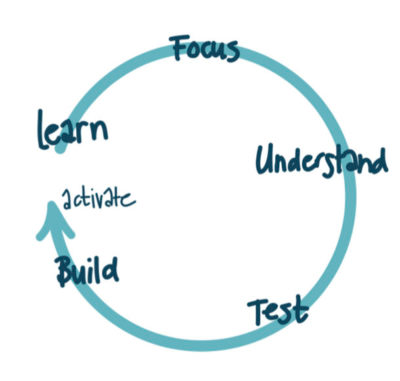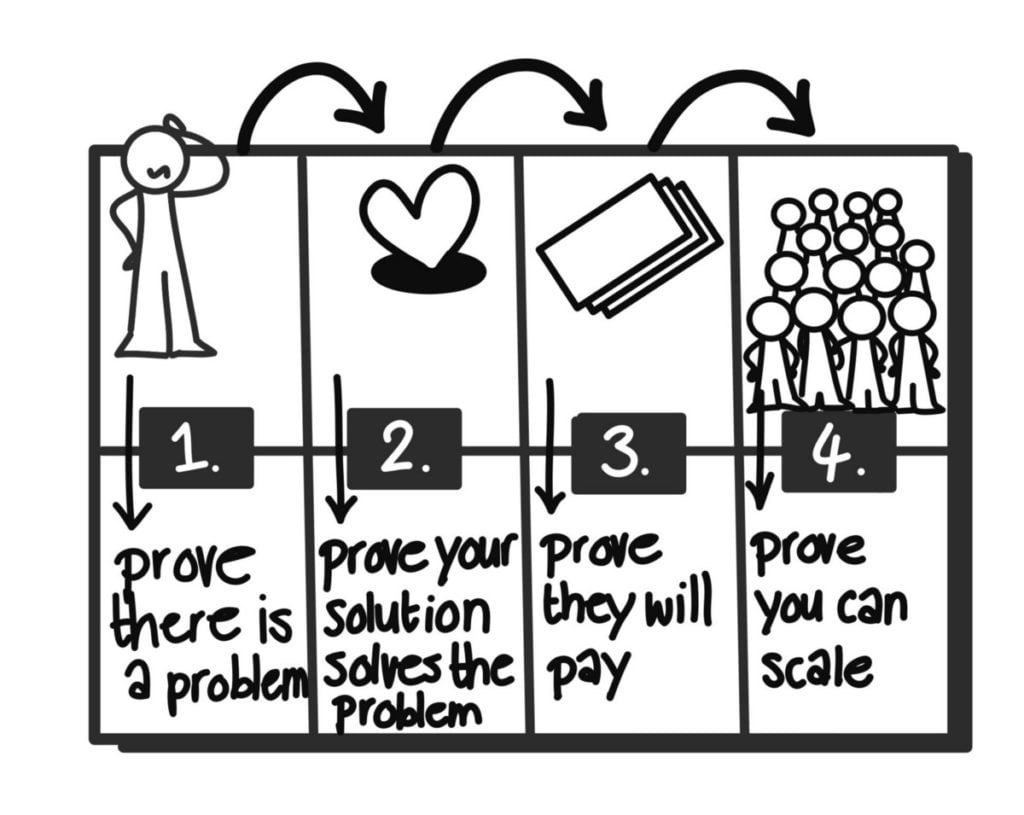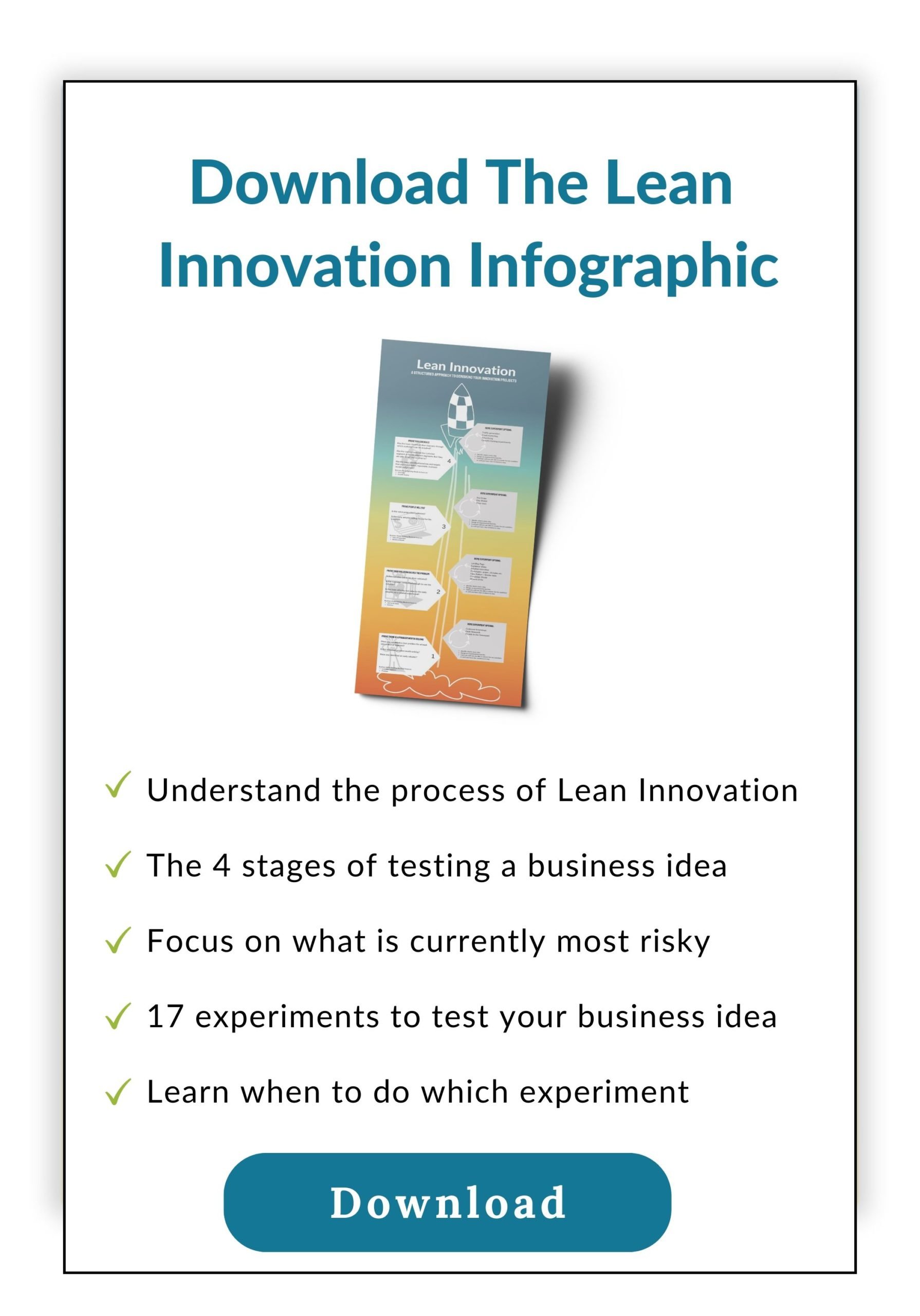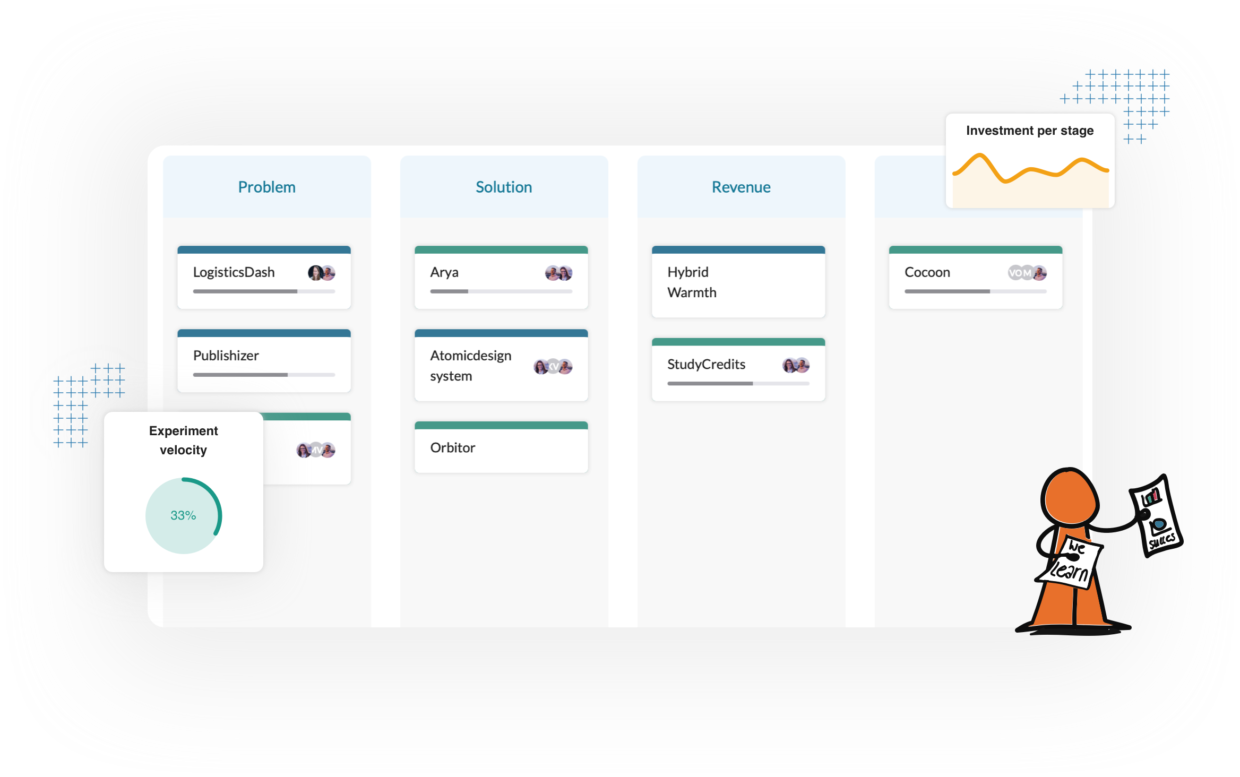How to start with business model validation today? (+Template)
Table of Contents
One of the hardest things we notice amongst the dozen of companies we worked with, is creating a structured approach to validating business models, or business ideas. In this blog, we discuss how to start with business model validation. Also, we provide a template so you can start validating your business model immediately.

Validating a business model requires a simple, pragmatic structure
Most (corporate) startups understand that they need to use lean innovation to run experiments, to gather the evidence to de-risk their business model. But to do that in a way that is structured and embedded in the way of working of the startup teams, instead of running experiments more incidental, is a lot harder.
After coaching around 300 to 400 startups we learned that we need a simple and pragmatic structure that works for people that have innovation in their job title. Innovation, and validating business models as a part of that, is a creative process, but at the same time if you are doing innovation in a corporate setting you need to know what to do when you sit down behind your desk on a Monday morning and you start “innovating”.
We needed to turn “innovation” into “work”, without killing the creativity and without turning innovation into a checklist.
Start by asking these questions
We came up with a way of working that consists of the following questions, that can be asked on a regular basis, usually in two-week cycles:
- What stage are you currently in
- What is currently most risky
- How can you test that?
- What have you learned from this experiment
- What decision can you make to take a step forward
Rinse and repeat. What stage in the business model validation process are you in, what is currently most risky, how can you that that?
It is a simple loop with a lot of theory behind it.
[convertkit form=5116887]
In what stage of the business model validation process am I?
To understand what stage a startup is currently in, or where they are in the process from a great business idea to a validated business model, we need to have an innovation framework. You need to create some stages each concept is going through.
We created such a framework a few years ago and called it the NEXT Canvas. We understood that there is a certain order in which you need to tackle this fuzzy journey:
- Prove there is a problem (worth solving)
- Prove you can solve that problem
- Prove your customer will pay
- Prove you can scale
Or summarised into 4 innovation stages:
- Problem
- Solution
- Revenue
- Scale

For each of these stages, we set key questions that startups need to be able to answer before they can go to the next stage. Only if you have validated a customer segment, understand their problems, and that the problems are significant enough to solve, does it make sense to prove that your envisioned solution can solve that problem or how customers are willing to pay.
Understanding the stage your startup is in, also makes it easier to understand what is currently most risky and how you can test that assumption.
What is currently the most risky?
Once you understand what stage you are in, you have to ask yourself what assumption is currently the most risky. You only have to look at assumptions up to your current stage. Not knowing the acquisition channels of your customer, is not risky when you don’t know who your customer is and what their needs are.
For each of your assumptions, you can ask two questions to determine their riskiness:
- How big is the impact on your idea if this assumption is not true?
- How much do you already know about this assumption?
You want to focus on the assumptions with the biggest impact and the least evidence.
Remember, an assumption is something you think is true without the evidence to back that claim. It’s your job to run experiments to gather that evidence and turn that assumption into a fact. The more evidence you have for an assumption, the lower the risk.
How can you test that?
By now you should have a list of assumptions that are the riskiest. You can either use Dan Toma’s high/low matrix to plot them or use GroundControl to display them into a nice ordered list.
Usually, you pick the assumption that is on top of your list. I like to pick the assumption that is in the earliest stage of the business model validation process and has the most risk. That means that an assumption from the Problem stage has more risk than an assumption from the Revenue stage (assuming you are already in the Revenue stage). Because I see previous stages as the foundation for the rest of your validation work. If the customer turns out to be the wrong one, your whole validation collapses.
Select the right experiment
So once you picked an assumption to test, understanding how to test it becomes relatively simple.
There are only so many relevant experiments, we identified around 18 of them, and when you look at the assumption stage, that number goes down fast. A round of interviews can probably validate an assumption in the Problem stage. A solution assumption could be validated with a landing page test or sales pitch. Etcetera.
We are basically going from zooming out and looking at your whole business model or idea (what stage are you in), to slowly zooming in more (what is currently most risky looking at all assumptions) and more (how can we test this one most risky assumption).
Once you know how to test your assumption and you created a good experiment, it is time to execute that experiment and get to work!
What have you learned from this experiment?
About two to four weeks later you should have finished your experiment and it is time to analyze the outcomes. This part is maybe the most important because you are determining what evidence you have gathered to back your assumption.
During the analyses, it helps to write down every lesson you learned, or each piece of evidence you gathered, and link that to one of your key questions for the stage of the validation process you are currently in. By doing this, it becomes much easier to show you have the answers to each of the questions: You can literally show the evidence that backs your confidence and by doing so you make this process much more data-driven, and less based on gut feeling.
We identify three possible outcomes from a validation experiment:
- You gathered enough evidence to validate the assumption
- You gathered enough evidence to invalidate the assumption
- You can’t make a decision
The first two outcomes, validation, and invalidation are both successful outcomes of an experiment. Invalidating might even be more important than validating. It is often easier to prove something is not true, than that something is true. (Customer Segment X is not willing to pay for our solution, is easier than validating that they are willing to pay, because how do they want to pay, when do they want to pay, and how much are they willing to pay are logical follow-up questions before you can really validate a revenue model).
If you are ready to start measuring the performance of your innovation teams through innovation accounting, the number of experiments per quarter and the ratio of successful vs unsuccessful experiments are two metrics that will give you already a lot of insights.
What decision can you make to take a step forward?
Once you analysed the experiment, you need to make a decision:
- Did we validate the assumption and do we persevere
- Did we invalidate and do we need to make a pivot
- Did we invalidate so much we should stop
After a validation, continuing to validate the next assumption is the logical next step. Ask yourself if you gathered enough evidence to answer your key questions, so you can go to the next stage.
If you invalidated an assumption you need to make a pivot or a course correction. You learned a risky assumption is not true, so what does that mean for your business model? Do you need to focus on a different customer segment? Do you need to find a different way to solve your customer’s problem? Or think of a different way to generate revenue.
After an invalidation you won’t go to the next stage, so you can ask yourself again: What is currently most risky, and continue your search.
It happens that you keep invalidating assumptions and you start to notice this business idea will not fly. Deciding to stop is a very valid outcome of a startup. You gathered enough evidence that the concept will not work at the moment and by stopping you free up your time and resources to continue on the next business idea. That is also a success! Only when you are not learning, you are failing.
How to start validating your business model today?
The title of this blog post promised a way to start with business model validation today. The easiest way to start is to sign up for GroundControl. Start filling in your assumptions, answering the impact/knowledge questions, and defining an experiment.
You can also download the NEXT Canvas for free and plot your assumption on it.
If you keep asking yourself what is currently the most risky and how can we test it, you are already 80% on the way to a structured approach to validating your business model. The rest is optimizing the process along the way.
Would you like to learn more about business model validation in dept? We’ll explain it in detail in our upcoming Lean innovation training course.

Timan Rebel has over 20 years of experience as a startup founder and helps both independent and corporate startups find product/market fit. He has coached over 250+ startups in the past 12 years and is an expert in Lean Innovation and experiment design.

